
A re you struggling to write articles quickly? Maybe you’re dealing with writer’s block, or just not able to post as often as you want to on your blog. If you want to learn how to write blog posts faster, you’re in the right place!
When you know how to write quickly, you can:
- Boost your posting frequency to target more keywords and grow your traffic
- Spend more time on your blog’s maintenance and design
- Become a guest post writing machine and reach a whole new audience
There are SO many benefits to learning how to write fast.
And writing faster doesn’t have to mean sacrificing quality. If you use the writing tips below, it’s possible to write a high quality blog post in under 30 minutes.
Just follow these experts tips to write faster and you’ll be able to produce high quality articles faster than you ever thought possible.
How to Write Faster: 22 Hacks
In This Guide:
- 1. Separate & Batch Every Step of the Writing Process
- 2. Keep an Ongoing List of Ideas
- 3. Know Your Most Productive Time of Day
- 4. Make Writing a Habit – and Stick To It!
- 5. Choose a Topic You’re Excited About
- 6. Turn Off Your Phone Notifications
- 7. Block Distractions With a Browser Extension
- 8. Use Music to Encourage Focus
- 9. Create a Detailed Outline to Guide You
- 10. Use the Right Software
- 11. Don’t Stop Writing to Do Research
- 12. Turn Off Spelling and Grammar Check
- 13. Save Typing Time With Text Shortcuts
- 14. Level Up Your Typing Speed
- 15. Or… Speak Instead of Typing
- 16. Save the Intro for Last
- 17. Create a Template for Intros & Conclusions
- 18. Race the Clock to Write Your First Draft
- 19. Write a Bad First Draft
- 20. Don’t Let New Ideas Distract You
- 21. Wait 24 Hours Before Editing
- 22. Use a Pre-Publishing Checklist
1. Separate & Batch Every Step of the Writing Process
When writing a blog post, most people will try to get through every step of the process in one sitting.
In other words, they’ll sit down and think of a topic to write about. Then they might start writing the post, stopping to research when they get stuck, or need some info.
They may write directly in WordPress or their favorite blogging platform, looking for images and doing the formatting while they’re writing.
Then when they’re finally done, they’ll give it a proofread and hit publish.
Sounds like a normal way to blog, right?
Well it might be typical, but it’s probably the least efficient way to write a blog post.
So, how can writers become more efficient?
Writers can publish blog posts faster by separating out each step of the writing process, and batching the same tasks together. That means doing all your brainstorming for multiple topics at once, doing all your research for multiple writing projects at one time, doing all your writing at one time, and then doing all your formatting and editing at one time.
Though it might sound like it would drag out the process, this actually saves a ton of time in the end.
That’s because of the way your brain works. Multitasking – which is what you’re doing when you try to write, research, edit, and format all at once – slows your brain down and makes it more inefficient. According to Harvard Business Review, it can actually lower your productivity by 40% and your IQ by 10 points!
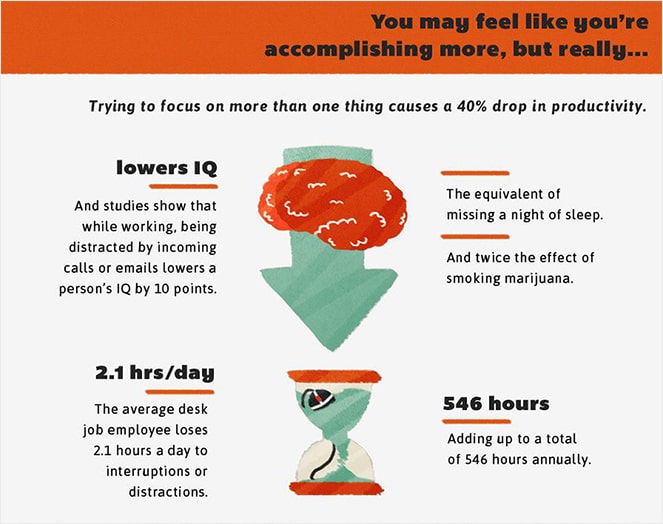
That’s why batching similar tasks together works so well. Your brain can stay in one mode, and doesn’t have to switch back and forth.
So, next time you sit down to work on your blog, don’t try to write a whole blog post from start to finish.
Instead, why not spend 30 minutes just brainstorming blog topics, or researching the next few posts on your list? Then the next time, you can focus on writing and nothing else.
2. Keep an Ongoing List of Ideas
Speaking of brainstorming blog topics, it’s a good idea to put aside time just for that.
But, as a creative person, you know that ideas come to you all the time – when you’re walking around, working on other tasks, or even when you’re trying to sleep at night.
That’s why it’s important to keep an ongoing list of blog post ideas that you can access from anywhere.
For some, that might mean a small notebook you carry with you everywhere, or you might find it easier to keep a list using a smartphone app like Google Keep.
With an easily accessible, ongoing list, you can get those ideas out of your head and go back to sleep, instead of losing sleep over it and forgetting by morning.
Then when you’re ready to work on your blog, you can hit the ground running.
3. Know Your Most Productive Time of Day
Productivity is really more about energy management than time management. Everyone might have the same hours in a day, but not all of those hours are equal!
You probably already know whether you’re a morning bird or a night owl. But did you know that your most creative time of day might be the opposite of your most productive time? For example, some people find it easier to be creative and turn off their inner critic when they’re still half asleep in the morning.
With that in mind, you may want to experiment with writing at different times of the day to see when you’re able to write faster.
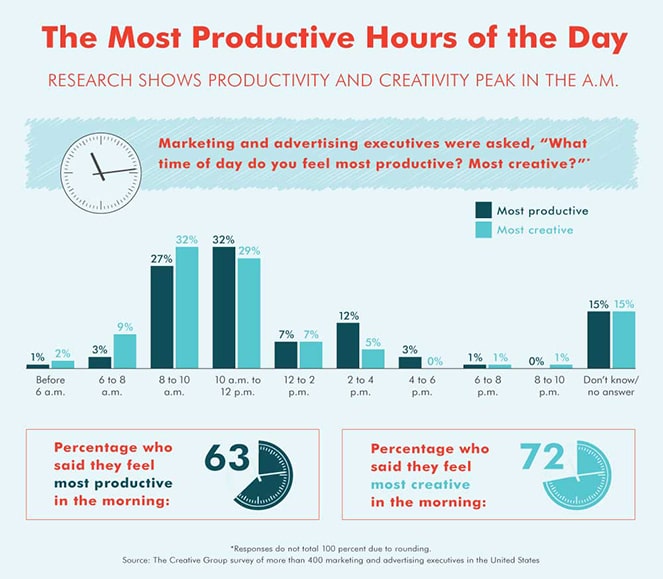
4. Make Writing a Habit – and Stick To It!
Human beings are creatures of habit. You may have noticed that when you’re following your typical routine, it’s easy to go with the flow and get things done.
That’s why you should make writing a routine. If your brain knows that you’re going to sit down and write first thing every morning, it will be easier for you to get into the writing mode and not procrastinate.
You can use an app like Streaks to track your new writing habit.
5. Choose a Topic You’re Excited About
If you’re following our tip #2 and keeping an ongoing list of ideas, you’ll have a lot of topics to choose from when it’s time to sit down and write.
To write as fast as possible, choose the topic that you’re most excited to write about on that day.
If you have an editorial calendar planned out, don’t be afraid to swap around ideas so that you can write about what comes easily to you in the moment.
If you’re excited and passionate about the topic, the words will flow easily. But if you’re trying to force yourself to write about a topic you don’t care about, it’ll take twice as long.
6. Turn Off Your Phone Notifications
Having social media notifications and text messages going off while you’re writing is a huge distraction. You should put your phone on “do not disturb” mode for an hour.
Better yet, put it away in another room where you won’t even see it.
Smartphone addiction is a real problem and will keep you from writing faster.
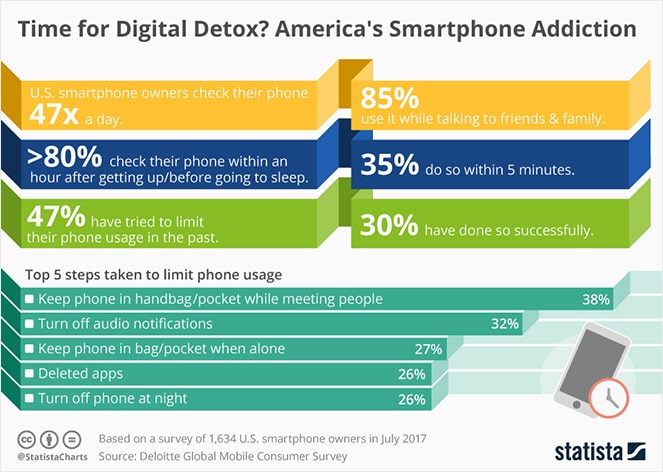
7. Block Distractions With a Browser Extension
Still tempted to check social media even with your phone in another room?
Use a browser extension like StayFocusd to block certain sites while you’re writing.
8. Use Music to Encourage Focus
Some people find typical music too distracting to play while they’re writing, especially if there are lyrics. According to research by Cambridge Sound Management, hearing intelligible words around you can be distracting because your brain will keep trying to figure out the words.
But the right kind of music can actually boost your concentration and help you to write more quickly.
For example, Brain.fm develops “functional music” that’s scientifically composed to help you focus.

9. Create a Detailed Outline to Guide You
Once you’ve done your research (including keyword research), there’s one more step before you start actually writing.
It might seem like a waste of time, but taking the time to put together an outline will definitely help you write faster.
And the more detailed your outline is, the better!
A well-organized outline is the best tool for preventing writer’s block. That’s because you can’t get stuck when you know exactly what to write next.
To get started, organize your research notes and keywords into subtopics. Then just make a bullet list with all the points you plan to cover in your blog post.
10. Use the Right Software
Now the preparation is done and you’re getting ready to start the actual writing.
Where will you draft your blog post?
Using the right tool can make all the difference in your writing speed. That’s because the wrong software can be full of distractions and slow you down, or even cause you to lose your work altogether. The last thing you want to have to do is write a post all over again after it wasn’t saved – trust me.
You’ll want to use a tool that…
- will automatically save your draft for you, so you won’t lose it
- has a distraction-free mode so you can easily focus
- can be extended with tools to boost your speed
Note: You do NOT want to have your post written by hand and then have to type it up – this will just double your writing time.
Many writers (even those who use a blogging platform like WordPress) will draft their posts in a separate tool like Google Docs. Google Docs works well because it is simple, easy to use, and will auto save your blog post drafts for you.
11. Don’t Stop Writing to Do Research
One of the biggest mistakes that can slow you down is to stop writing to do more research. It can be so tempting while quickly Google for some statistics or a link you need in your article.
But actually, you should NEVER do this if you want to write as fast as possible.
Instead, make sure you’re following tip #1 to separate and batch every step in your process. That means doing all your research first, before you start writing.
Then once you start writing your blog post, don’t stop. If you’re missing some important information or can’t think of the right word, you can borrow a trick from journalists and just write “TK”, which is editor’s jargon for “to come”.
Then, when you’re finished, you can go back and search for “TK” in your post, and replace it with the right information.
12. Turn Off Spelling and Grammar Check
Editing while you’re writing will slow you down, so turn off those spelling and grammar checks! You can go back and fix any mistakes after you’re done writing.
Those squiggly red and green lines are way too distracting, so don’t tempt yourself.
To turn off spell check in Chrome, go to your browser settings and search for “spell check”. Then click the slider to turn it off.
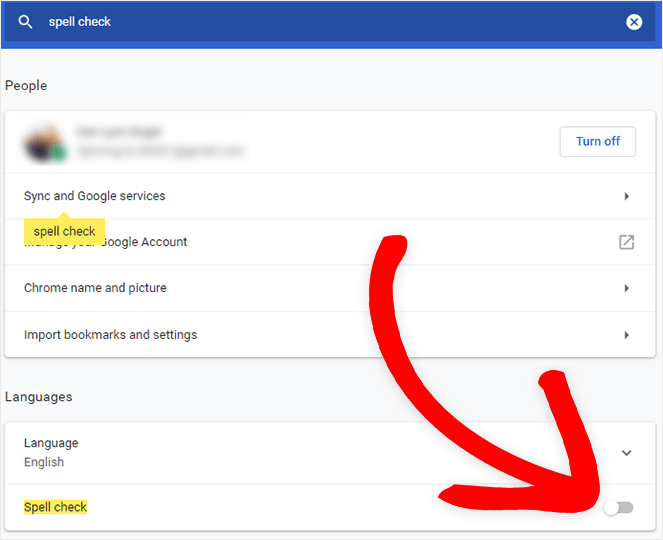
To turn off spell check in Google Docs, click on Tools » Spelling and grammar and then make sure there’s no checkmark next to Show spelling suggestions.
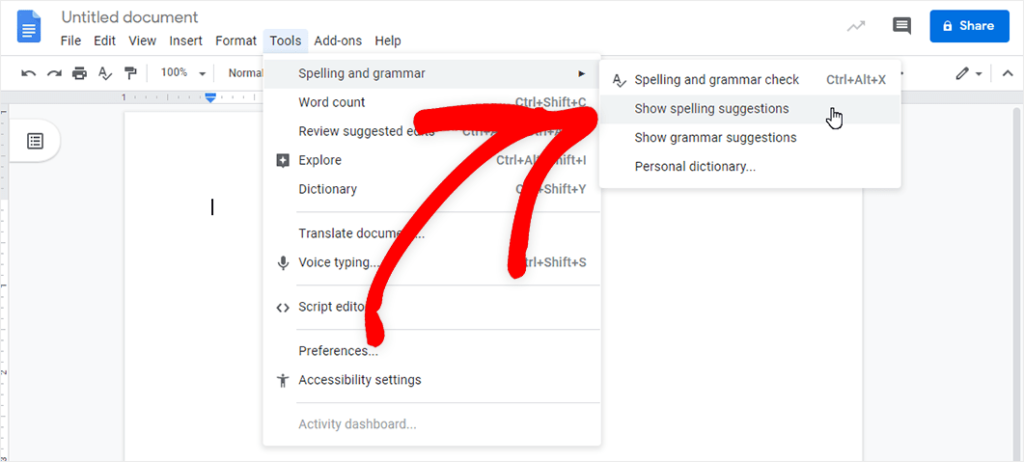
13. Save Typing Time With Text Shortcuts
Here’s a secret tip to improve your writing speed: with the right tool, you can actually create your own keyboard shortcuts for words and phrases that you type often.
TextExpander is a great tool for this.
For example, let’s say your blog has a long name like “Frank’s Fantastic Fashion Blog”. Instead of typing it out every time, you can create a simple shortcut like fffb. Then, every time you type fffb, TextExpander will automatically replace those letters with the full name.
This can save you a ton of time. TextExpander will even track your stats so that you know exactly how many keystrokes you’ve saved.
14. Level Up Your Typing Speed
If you could increase your typing speed by 10 or 20%, think how much time you’d save per blog post!
To test where your typing speed is now, try this typing test from LiveChat.
Now to level up your typing speed, you’ll have to put in a little practice. Set aside 20 minutes a day to practice your typing skills. To make it fun, you can use a game like Typeracer.
15. Or… Speak Instead of Typing
Still not typing fast enough to keep up?
What about dictating your post instead?
Voice recognition has come a long way in the fast few years. There’s no need to buy expensive software to dictate your blog posts.
Actually, if you’re using Google Docs you can do it right there! Just click on Tools » Voice typing to get started.
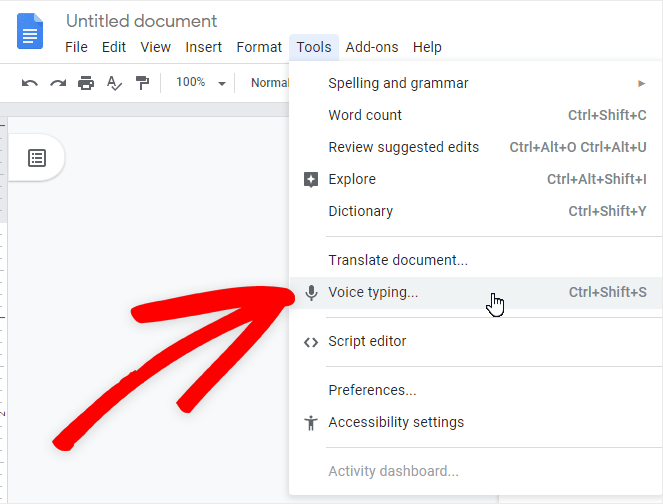
16. Save the Intro for Last
Staring at a cursor blinking on a blank screen can be paralyzing.
If you’re getting writer’s block when trying to write your introduction, it’s best to just skip over it.
The intro is often the hardest part of a blog post to write, but it’s much easier when you save it for last.
17. Create a Template for Intros & Conclusions
Speaking of intros, they’re often difficult to write because they’re so important. If you don’t grab you’re reader’s attention right away, they won’t stick around to read the rest of the post.
To write a good intro, there’s no need to start from scratch every time. Instead, you can create your own template or formula for writing intros.
For example, one popular copywriting template often used for intros is the Problem-Agitate-Solve method:
- Problem: Empathize with the reader and the problem they’re facing.
- Agitate: Talk about the consequences of the problem and why it needs to be solved.
- Solve: Explain how your blog post will solve the reader’s problem.
This simple 3-part structure is a great way to write an intro that hooks your readers in.
You can do the same for your conclusions as well. For example, do you often end your blog posts with a call to action to leave a comment, or follow you on social media. Instead of typing it out every time, you can create a template with a few variations of your conclusion that you can choose from for each post.
18. Race the Clock to Write Your First Draft
When it comes to the actual writing, it’s tempting to let your mind wander even after you’ve gotten rid of all other distractions.
The best way to stay focused and keep your mind on track is to race against the clock.
Once you have everything in place to write your draft (your research, detailed outline, and template), set a timer for 20 minutes and start writing.
Don’t worry about formatting, spelling, images, or anything else – just write your first draft as fast as you can, before the timer runs out.
Didn’t finish? Take a 5 minute break, and then set the timer again. (This is similar to the Pomodoro technique that works really well to boost your focus.)
19. Write a Bad First Draft
Your first draft doesn’t have to be Shakespeare.
It doesn’t even have to be very good – so write quickly without thinking of the best turn of phrase, or choosing the perfect word to capture your thoughts. No opening up the thesaurus – just write!
What matters now is getting the thoughts on paper (or screen), not making them sound good.
In the editing stage, you can fix any mistakes.
20. Don’t Let New Ideas Distract You
While you’re writing, you might get ideas for new topics to cover that aren’t included in your outline. You might be tempted to go off on a tangent or start researching your new ideas.
Don’t!
Stick to your outline for now.
Instead, keep a notepad open on the side. This can be a real physical notepad, or a simple app like Windows Notepad.
Then, if you have an idea pop up, you can jot it down and forget about it.
Once you’re done writing, you can review your ideas and decide what to do with them.
21. Wait 24 Hours Before Editing
To be a good editor, you need to be objective and unbiased.
But if you’ve just finished writing, that’s impossible – you’re still seeing the work as a writer, not an editor.
That’s why you need to wait at least 24 hours before you try to edit your own writing.
Once you have some distance from the blog post, you’ll be able to read it objectively. This will help you to be ruthless in your editing and not too attached to your first draft, which is needed if you want to write a high quality blog post.
22. Use a Pre-Publishing Checklist
Last but not least, one of the best ways to write blog posts faster is to use a checklist before you publish a post.
A checklist can help you remember to:
- do a final spelling and grammar check
- double check all your links are correct
- make sure your images look good
- add categories and tags in WordPress
And it will keep you focused on the editing process if you know exactly what to look for.
At Blog Tyrant, we created the ultimate list of blogging tips for you to use. You can bookmark it and refer back to it whenever you’re getting ready to publish a post.
That’s it! Now you know how to write a blog post fast. If you put just a few of these into practice for your next blog posts, you’ll see a huge difference in your writing and publishing speed and be able to write more than ever.
Not sure what to write about next? See our roundup of the best blog post ideas you can steal.


If you are hoping to guest post:
PLEASE, do not just send a generic email saying, “I’d like to guest post.
Great ideas on how to write blog faster
Exactly what I was looking for! Great tips! Want to spend more time on blog posts verses creating a poster and writing about it. Looking forward to reading more of what you say about blogging.